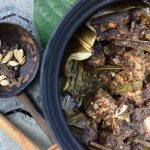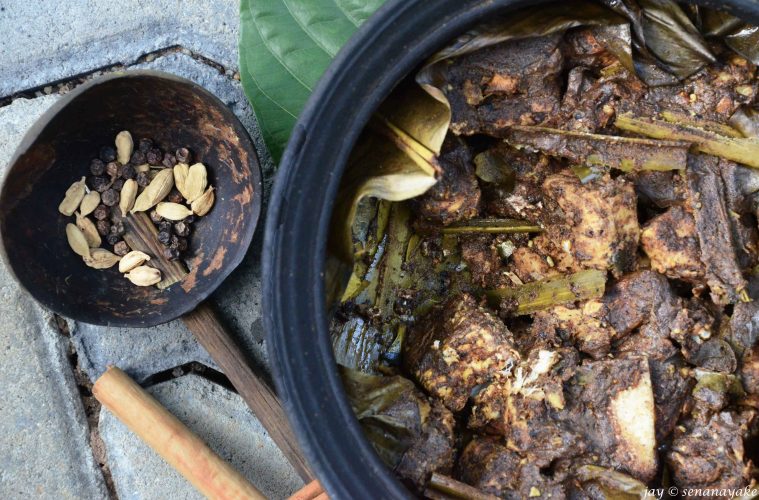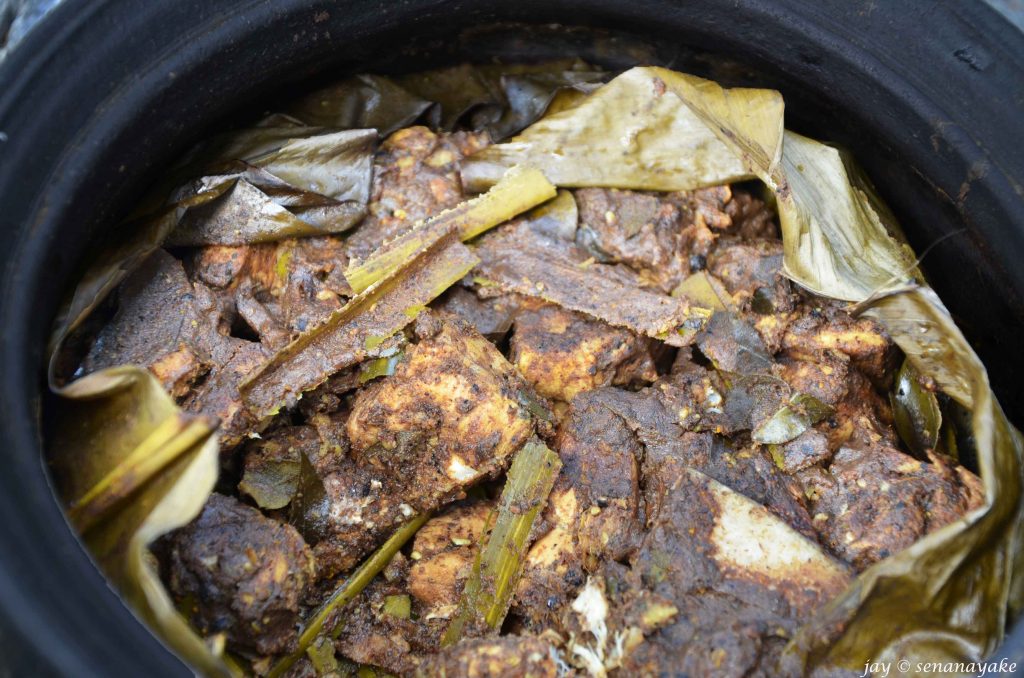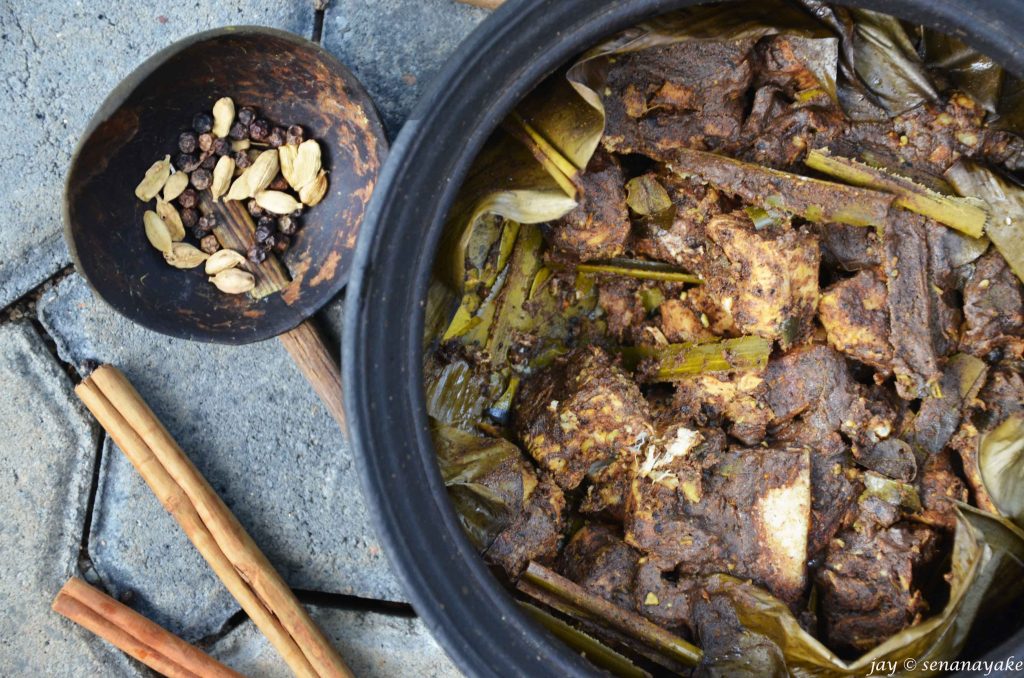Every Saturday morning a smokey, delightfully spicy yet surprisingly mild mist nudges my nostrils. It envelopes me in a cloud and fills me with delicious dreams that a sleepy smile draws across my lips with my eyes fast shut still. And I would stretch and open my eyes to a semi-darkened room, knowing that amma is making ambul thiyal for breakfast.
Sadly, now that I’m married and moved away, I do not privilege from such luxurious comforts.
Considering the fact that there is an entire floor separating my room from the kitchen, it can only be imagined how very fragrant this Sri Lankan specialty is. Now I know what you are thinking: fish – stinky, smelly stuff. Yuck! And being no fan of fish myself, I understand your sentiments.
But I love ambul thiyal!
Maalu Ambul Thiyal, which can be roughly translated to sour fish curry has its origins in Ambalangoda, Sri Lanka’s beautiful south coast. Today it has the status of a national dish and is loved universally for its intense flavour and the utter yumminess of the product. Seeped in a number of choice spices, the fish is coated in a goraka paste (brindleberry) and cooked over a low heat, ideally over a woodfired stove.
Ah the aroma!
Due to all those spices and the sourness of the goraka, the fish will lose all of those fishy, slimy unpleasantness. What will be left are the good bits of fish – a delightful mix of spices and goraka sour mingling, interacting. However, the most extraordinary thing about this delicacy is that it lasts for weeks and weeks in room temperature! This in itself is a miracle, especially in a hot and humid country such as ours. It’s actually the best of not both, but all worlds possible!
There are traditional ways of preparing this and then there’s the easier, more modern way. My mother, being the true southerner that she is, prefers to go all the way and make it just like her mother and her mother’s mother had made it. And I am determined to do the same as well.

- Yield: 4 servings
- Prep Time: 15 minutes
- Cook Time: 20 minutes
Sri Lankan Maalu ambul thiyal
Ingredients
- Tuna - 500g (any firm fleshed fish such as Yellowfin tuna (Kelawalla), Sail fish (Thalapath) can be used but I have found that the Skipjack tuna (Balaya) works best )
- Onion - 50 g, sliced
- Fenugreek seeds - ½ tsp
- Pepper - 1 tsp, whole
- Pandan leaf - 1 piece
- Salt - As needed
- Water - ½ Cup
- Banana leaf - 1 piece
- For the paste
- Cardamom - 6 pods
- Cinnamon - 6 tsps, powdered
- Cumin powder - 1 tsp
- Coriander powder - 1 tsp
- Pepper - 1 tsp
- Chili powder - 1 tsp
- Roasted curry powder - 1 tsp
- Garlic - 3 cloves, crushed
- Green chili - 1, chopped
- Chili flakes - 1 tsp
- Goraka - 5 pieces
- Salt - To taste
Instructions
- Boil a little water and add 2 pieces of goraka. Boil for about 10 minutes. Let it cool. Keep the water aside.
- Grind the softened goraka pieces and all the ingredients in the “paste” section together. (My mother used to hand-grind everything on the heavy grinding stone in the kitchen. But now she just uses the grinder. I do sense a difference in taste though between the two methods) Set aside.
- Wash the fish with clean water and a little lime. Combine it with the paste you made and set aside.
- Line a large clay pot in the piece of banana leaf. Place the paste covered fish, onions, fenugreek and the pandan leaf.
- Add the water that you boiled the goraka in. Cook on high covered on a wood fired stove until the mixture has started bubbling.
- Fill another clay pot with live burning coals. Remove the cover of the clay pot containing the fish and keep the clay pot filled with the burning coals on top of the other pot like its lid. The purpose is to create a grill like atmosphere with heat hitting the fish from above as well.
- Cook like this on low heat until the paste thickens to just enough coat the pieces of fish. Serve with rice, bread or even, with crackers!
Gimme a plate of warm rice, a piece of fish ambul thiyal and a good, spicy vibrant pol sambol and the Gods are appeased.
This sultry and quietly elegant dish is decidedly exotic. The nose benefits from a loud hit of oriental cheer just as you lift the lid and prepares your mind, teasing it with fragrant fingers. One has to use one’s fingers to truly enjoy this Sri Lankan delicacy. Your fingers, gliding along the rich, sumptuous gravy covered pieces of fish is definitely satisfying and just a little pressure will get you firm flakes of flavourful fish, breaking off from the main hulk. The taste is one that baffles even the most prolific of food connoisseurs. The sour, the fragrant, the spicy and the chili come together in perfect complement to the fish, bringing about a harmony so rare in such contrasting nuances. The flavours are so concentrated that a bite is literally like a bomb of goose bump-inducing happiness exploding in your mouth. The delightfully pungent fish is laced with the green notes of cardamom, the warm sensuality of the cinnamon and the deep, dark sourness of the goraka, mildly scented with the curry leaves and pandan leaf. The coal laden pot on the top caramelizes and seals the flavour into the pieces of fish, yielding a delicious crust that provides a lovely contrast to the softness of the flesh. The smoke from the wood fired stove gives the dish a lovely smokinessthat fills your mouth and serenades the senses in that seductive way that invites you to indulge and satiate. The banana leaf lends its very own scent to the dish, encompassing it in a smoky, leafy, warm embrace that lingers on your tongue even long after you have taken your last bite.
This I give you, is the essence of exotic Sri Lanka, in a pot.
It might not look like much, but what it can give you is unlike anything you have ever experienced before – just like the people of this exotic paradise isle ;)
Cooking tips
- Choose a firm fish for the dish. Firm flesh fish yields the best results.
- Washing the fish with lime helps eliminate the fishy odor and also any harmful parasites that may be living in the flesh.
- This is the traditional method of doing the ambul thiyal with the coal pot, the banana leaf and the whole jingbang. You can of course ditch the banana leaf and the pot full of coals and instead cook on low heat with the pot covered. Of course you would not get that smokey banana leaf flavour and the caramalization of the top, but it would yield a descent enough ambul thiyal. In fact, I ditch the coal pot more often than not.
- The wood fired stove (dara lipa) yields the best results and gives it that lovely smoky flavour characteristic to the ambul thiyal. But of course you can use a regular stovetop for the purpose. My mother does it all the time and it’s still very, very delicious.
- The beauty of this is that you can keep this dish for weeks on end without refrigerating! The goraka and the spices act together in preserving the fish and this was a well known method down south of the island for storing all that excess fish without letting it go to waste.



